
The close quarters of Robert's Quartet have ignited wide-spread star birth in two of its four galaxies
(Image: FORS2/VLT/ESO)
Intergalactic attraction creates bumper star crop
* 17:15 07 November 2005
* NewScientist.com news service
* Maggie McKee
"Hundreds of new stars are igniting in the wake of intense gravitational interactions between four galaxies, new observations reveal.
The four galaxies – called Robert's Quartet – lie about 160 million light years from Earth in the southern constellation Phoenix. They are crowded into a space just 150,000 light years across – only 1.5 times the width of our galaxy, the Milky Way.
That proximity makes them one of the best known examples of a compact group of galaxies, whose members gravitationally disturb each other. In the group's largest galaxy, NGC 92 (left), that interaction has sparked the creation of about 200 star-forming regions and unravelled a stream of gas and dust stretching 100,000 light years.
Nearly 60 stellar nurseries have sprung up in the irregular galaxy NGC 87, in the upper right of the image, while a ring of enhanced star birth circles the spiral galaxy NGC 89 (lower middle). The observations were made with the FORS2 spectrograph on the European Southern Observatory's Very Large Telescope in Chile."
(Image: FORS2/VLT/ESO)
Intergalactic attraction creates bumper star crop
* 17:15 07 November 2005
* NewScientist.com news service
* Maggie McKee
"Hundreds of new stars are igniting in the wake of intense gravitational interactions between four galaxies, new observations reveal.
The four galaxies – called Robert's Quartet – lie about 160 million light years from Earth in the southern constellation Phoenix. They are crowded into a space just 150,000 light years across – only 1.5 times the width of our galaxy, the Milky Way.
That proximity makes them one of the best known examples of a compact group of galaxies, whose members gravitationally disturb each other. In the group's largest galaxy, NGC 92 (left), that interaction has sparked the creation of about 200 star-forming regions and unravelled a stream of gas and dust stretching 100,000 light years.
Nearly 60 stellar nurseries have sprung up in the irregular galaxy NGC 87, in the upper right of the image, while a ring of enhanced star birth circles the spiral galaxy NGC 89 (lower middle). The observations were made with the FORS2 spectrograph on the European Southern Observatory's Very Large Telescope in Chile."

No comments:
Post a Comment